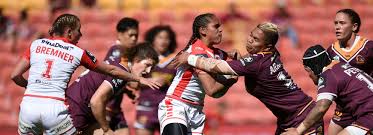Inaugural NRL Women’s Premiership kicks off
At Suncorp Stadium on Sunday afternoon, the Brisbane Broncos women’s team made history as part of the first ever round of the National Rugby League Women’s Premiership (NRLW).
The game, in which the Broncos comprehensively defeated the St. George Illawarra Dragons 30 to 4, was the first half of the Brisbane double-header.

The following elimination final between their male counterparts saw Brisbane suffer a 48-18 thrashing, putting an unexpectedly abrupt end to their 2018 season.
The Sydney Roosters and the New Zealand Warriors make up the other half of the NRLW draw, which will run for a total of four weeks in concurrence with the NRL’s premiership final series.
Each team brings an array of both on- and off-field experience to the table, with signings ranging from ‘semi-professional’ athletes of the Australian Jillaroos, the national women’s rugby league side, to up-and-coming young talent scouted at grassroots carnivals.
The NRLW is a breakthrough for Australian rugby league, offering female athletes their first opportunity to compete and showcase their talent at the national level.
Ali Brigginshaw, captain of the Brisbane Broncos women’s team, described running out onto the field before an 18,000-strong home crowd as ‘surreal’.
“I never knew what it felt like…the feeling of that Brisbane crowd is just amazing, that’s a surreal feeling out there,” Ms. Brigginshaw said at her post-match conference.
“Not just for us, but for the Dragons girls as well. It’s good to see [supporters] getting behind the women’s game.”
In an overwhelmingly male-dominated sport, the Premiership represents the NRL body’s recognition of the barriers that prevent women from turning their passion for rugby league into a career the same way men can.
However, even at a structural level, clear disparities between the men’s and women’s leagues remain.
The 2018 NRL season had 26 rounds of regular competition before the finals series, compared to just three plus a season decider for the NRLW. Additionally, the women’s sides lose 20 minutes of game time, receive far less media coverage, and experience the all-too-common pay gap.
Dr. Rebecca Olive, a professor and researcher of gender in sport at The University of Queensland, agrees that while the NRLW is a landmark initiative, it also further highlights how stereotypes of women’s roles in society and their resulting inability to ‘commit’ to sport inhibit equal opportunity.
“Historically, women have been seen as second-class citizens when it comes to sport – we talk about ‘women’s sport’, indicating that women’s sport is a kind of subset of ‘sport’, which stands for ‘men’s sport’,” Dr. Olive said.
“When they are represented, women are often presented as mothers or the wives and girlfriends of men, or discussed in terms of their bodies.”
“I would say that this is changing. For example, the advertising campaigns about the AFLW and NRLW have primarily focused on the women as athletes…that their skill is put before their roles as women, wives and mothers.”
This almost-constant reinforcement of sportswomen’s duties as caregivers before their talent as athletes continues to cripple women’s ability to turn sport from a hobby into a profession. This is compounded by the fractional salary they receive for their efforts on the field.
To compete in the NRLW, the majority of the athletes had to take leave from their full-time employment, as well as their other roles as parents, spouses, and friends. With some even moving interstate, these women are willing to temporarily put their entire lives on hold for an incredibly brief and poorly remunerated opportunity to experience rugby league at the national level.
Meanwhile, male rugby league athletes can turn their passion for the sport into a full-time career with comparative ease, regardless of their other responsibilities as fathers, husbands, or mates.
For the 2018 NRL season, the average player salary was $371,000, excluding individual sponsorship or advertising contracts. For elite male players, the idea of rugby league as a ‘hobby’ or ‘side-gig’ simply wouldn’t be taken seriously.
And yet it’s this very same expectation that sport isn’t, or shouldn’t be, a viable career option for female athletes that is debilitating the progress of women’s sport.
While these could all be dismissed as ‘teething problems’ of the first season, there’s no denying that the NRLW Premiership is but a step in the right direction. Real and lasting change will require a concerted effort from the entire rugby league community, from grassroots to the highest corporate levels, men and women alike.
To be sure, the NRLW has kicked things off; but rugby league and the wider sporting industry have a long way to go before even coming close to true equality of opportunity and outcme for women.
